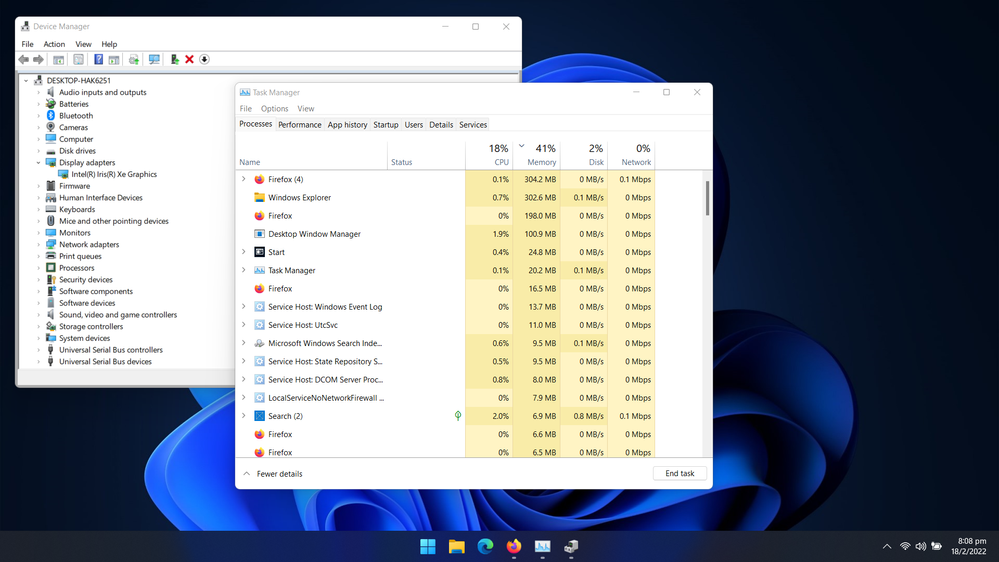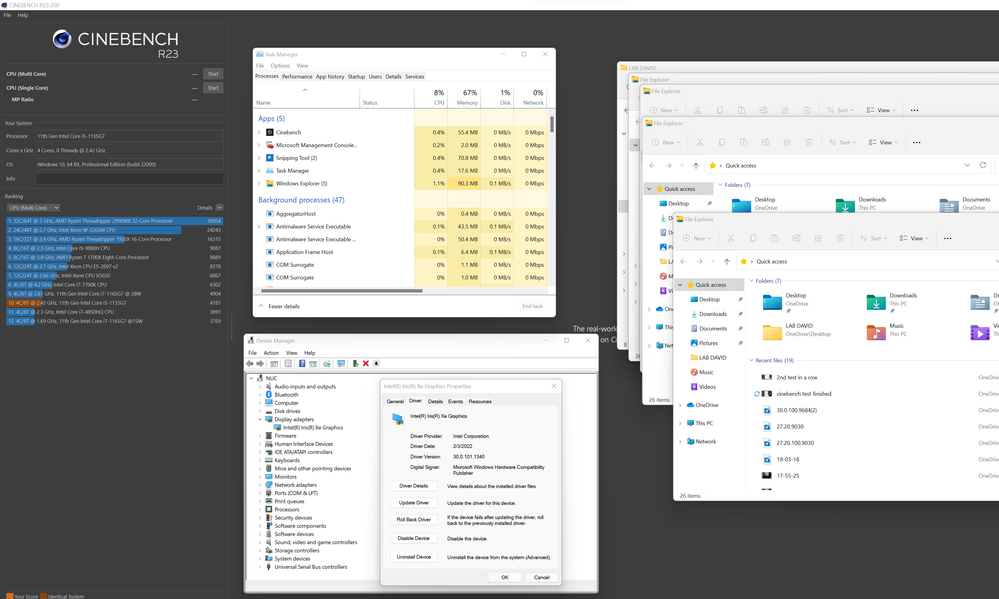- Marcar como novo
- Marcador
- Subscrever
- Silenciar
- Subscrever fonte RSS
- Destacar
- Imprimir
- Denunciar conteúdo inapropriado
I discovered that the reason the Windows Explorer is very high on boot up is actually because of the graphics driver. When I disabled the Intel graphics driver, the memory goes down after restarting the Explorer but if it's enabled, it becomes abnormal. Tried turning off all visual effects without disabling the driver and then restarting the Explorer but no change.
Here's the screenshots of both enabled and disabled of the Intel graphics driver, look at the Windows Explorer memory usage in both images:
Graphics driver enabled:
Graphics Driver disabled:
I clean installed Windows 11 again because of that, clean installed the graphics driver as well.
Intel DCH driver 30.0.101.1340
Link copiado
- Marcar como novo
- Marcador
- Subscrever
- Silenciar
- Subscrever fonte RSS
- Destacar
- Imprimir
- Denunciar conteúdo inapropriado
Downgraded the DCH driver to version 30.0.101.1191 and the Windows Explorer memory usage went down.
Will monitor if the memory leak happens again.
- Marcar como novo
- Marcador
- Subscrever
- Silenciar
- Subscrever fonte RSS
- Destacar
- Imprimir
- Denunciar conteúdo inapropriado
Hello Xillvion
Thank you for posting on the Intel️® communities and thank you for bringing this to our attention. We will investigate this request and the updates will be posted on the thread.
Regards,
David G
Intel Customer Support Technician
- Marcar como novo
- Marcador
- Subscrever
- Silenciar
- Subscrever fonte RSS
- Destacar
- Imprimir
- Denunciar conteúdo inapropriado
Downgrading the graphics driver still has the Windows Explorer memory leak as shown in the screenshot, should not be 200mb or more:
To reproduce the leak, just use the system for a few hours or maybe stress testing the GPU, CPU and RAM for 24 hours, afterwards restart the Windows Explorer process or the OS.
- Marcar como novo
- Marcador
- Subscrever
- Silenciar
- Subscrever fonte RSS
- Destacar
- Imprimir
- Denunciar conteúdo inapropriado
What is your Windows 11 build # you running?
I'm having the same problem ever since upgrading to Intel DCH driver 30.0.101.1340 or it may be coincidence with latest Windows 11 update.
Will have to restart Windows explorer every time I logon now otherwise start menu and taskbar won't even show up!
Tried downgrading driver issue seemed to be gone but comes back every restart making me think it might actually be a Windows 11 update issue.
- Marcar como novo
- Marcador
- Subscrever
- Silenciar
- Subscrever fonte RSS
- Destacar
- Imprimir
- Denunciar conteúdo inapropriado
Windows 11 Build 22000.527
My previous 10th gen Intel UHD Graphics laptop didn't have this problem, but I don't know why nobody reported this issue until I did so. Thinking of clean installing Windows 10 but it will mean delaying fixes for this. Maybe you should do so?
- Marcar como novo
- Marcador
- Subscrever
- Silenciar
- Subscrever fonte RSS
- Destacar
- Imprimir
- Denunciar conteúdo inapropriado
Yeah only reason I"m stuck with Windows 11 is that I have new 12gen Intel cpu that runs best on Windows 11 but if didn't have that would definitely go back to Windows 10 if you can since Windows 11 seems quite unreliable in comparison.
Very annoying to have to bring up task manager and restart Windows Explorer everytime I log onto Windows 11 😫
Plenty of reports about it to Microsoft itself via Feeback Hub how you report bugs to them
and you can see from their official responses that it seems to be an ongoing issue and they keep releasing fixes for it
- Marcar como novo
- Marcador
- Subscrever
- Silenciar
- Subscrever fonte RSS
- Destacar
- Imprimir
- Denunciar conteúdo inapropriado
I don't think a Windows update is causing this at all. Does your system have a secondary GPU? To be exact, something dedicated and more powerful, but not from Intel. I want to know if it's a Intel driver problem or a Windows problem.
Also, did you find this post from Reddit or elsewhere? Other people on that platform also said they have a problem with it. I'm trying to get everyone's attention since it's a serious bug.
- Marcar como novo
- Marcador
- Subscrever
- Silenciar
- Subscrever fonte RSS
- Destacar
- Imprimir
- Denunciar conteúdo inapropriado
Anyways, I disabled Intel RST VMD in the UEFI settings and clean installed Windows 11 (for the 3rd time) yesterday. Will have to monitor the Explorer memory usage... for a few days?
- Marcar como novo
- Marcador
- Subscrever
- Silenciar
- Subscrever fonte RSS
- Destacar
- Imprimir
- Denunciar conteúdo inapropriado
Yeah picking up a new NVME drive today so I can install clean copy of Windows 11 myself.
- Marcar como novo
- Marcador
- Subscrever
- Silenciar
- Subscrever fonte RSS
- Destacar
- Imprimir
- Denunciar conteúdo inapropriado
Make sure Intel VMD is disabled in the UEFI settings, backup any important data before doing so, if any.
That way, you can update the firmware of whatever NVME drive you have.
- Marcar como novo
- Marcador
- Subscrever
- Silenciar
- Subscrever fonte RSS
- Destacar
- Imprimir
- Denunciar conteúdo inapropriado
Is there any new info on this? It would seem that creating the Explorer dump file is needed, don't want to make this go on a year later like the dwm.exe memory leak in 2020.
- Marcar como novo
- Marcador
- Subscrever
- Silenciar
- Subscrever fonte RSS
- Destacar
- Imprimir
- Denunciar conteúdo inapropriado
@Xillvio thank you for the updates. We completed our testing and investigation, we tried to replicate this issue in our labs but we didn't get the same results:
The best option is to report this to the system manufacturer and Microsoft support since it seems to be related to the configuration/OS image. Please keep in mind that this thread will no longer be monitored by Intel. Thank you for your understanding.
Regards,
David G
Intel Customer Support Technician
- Subscrever fonte RSS
- Marcar tópico como novo
- Marcar tópico como lido
- Flutuar este Tópico para o utilizador atual
- Marcador
- Subscrever
- Página amigável para impressora





